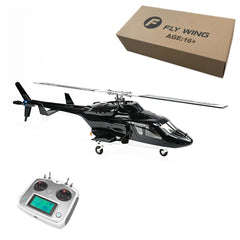Have you ever held your breath as your RC helicopter wobbled in a gentle breeze, fighting to maintain its position? This frustrating scenario plagues many RC enthusiasts, with over 70% reporting crashes linked to flight instability, according to RC community surveys.
At the heart of every great RC helicopter is a solid flight controller—this is the brain that controls everything from stability to responsiveness. The good news?FLYWING's recent H1 to ACE flight controller upgrade takes stability and precision to a whole new level.
FLYWING is renowned for high-performance RC helicopters. Now, they've made a monumental shift from the capable H1 controller to the advanced ACE flight control system. This isn't a minor update; it's a leap that redefines stable flight. In this article, we’ll break down the H1 vs ACE controller differences.
Why Stability is Everything in RC Flight
Before diving into the technical specs, let's understand why stability matters so much:
- For Beginners: A stable helicopter is a forgiving one. It builds confidence, shortens the learning curve, and prevents costly crashes.
- For Advanced Pilots: Precision is built on a foundation of stability. It allows you to execute complex maneuvers like coordinated turns and precise hovering with trust and accuracy.
- For Aerial Photographers: Stability is non-negotiable. It's the difference between buttery-smooth, professional video and shaky, unusable footage.
With the new ACE flight controller from FLYWING, this level of stability is enhanced dramatically, making it easier than ever for both beginners and experienced pilots to achieve smooth and controlled flights.
Understanding H1 and ACE Flight Controllers: Key Differences
What is the H1-lite Flight Controller?
The H1-lite serves as FLYWING's entry-level flight controller for models like the FW450L Airwolf, excelling in basic modes such as Airplane Mode and Return-to-Home (both supported). It handles GPS-dependent tasks well. Key limitations include no Attitude Hold Mode for stable angles without GPS lock, making it prone to instability in windy or indoor settings.

Usability is another hurdle, with compass calibration requiring PC software and wired connections—time-consuming for quick setups. Safety features like Low Battery Return-to-Home exist, but the absence of Pre-Flight Battery Charge Detection leaves room for errors.
Introducing the H-ACE System
Enter the H-ACE flight controller: FLYWING's 2025 innovation designed for precision and ease. Built with internal GPS for better durability and signal reliability, it introduces wireless compass calibration, slashing setup time. Features like Built-in Multiple Aircraft Parameters make it versatile across FLYWING models, enhancing adaptability.

Head-to-Head Comparison
Below, we break down the key differences between the two to understand how the ACE system brings substantial improvements in performance and stability.
| H1-LITE scale | H-ACE scale | ||
| Airplane Mode | GPS Mode | √ | √ |
| Return-to-Home Mode | √ | √ | |
| Attitude Hold Mode (aircraft maintains a stable angle without full GPS lock) |
× | √ | |
| Manual Mode | √ | × | |
| Intelligent Stunt | × | × | |
| Functionality | One-Key Inverted Flight (instantly flips into upside-down flight) |
× | × |
| Stick-Controlled 3D Roll | × | × | |
| One-Key Figure-Eight / Circle Flight (automatic flight path in figure-eight or circle) |
√ | × | |
| Coordinated Turn | × | √ | |
| Smooth Takeoff | × | √ | |
| Smooth Landing | × | √ | |
| One-Key Control Sensitivity Switch (quickly toggles between control feel/sensitivity modes) | × | √ | |
| Usability | Compass Calibration Method | Requires PC Software Wired Calibration | Wireless Calibration |
| Built-in Multiple Aircraft Parameters | × | √ | |
| Safety | Low Battery Return-to-Home | √ | √ |
| Auto Return-to-Home on Lost RC Signal | √ | √ | |
| Pre-Flight Battery Charge Detection | × | √ | |
| Auxiliary Devices | ELRS Telemetry | × | √ |
| Navigation Light Control | × | √ | |
| Retractable Landing Gear | × | √ | |
| Hardware Structure | GPS Module | External | Internal |
| Servo Port | Standard Pin Header | Custom Gold-Plated Fool-Proof Connector | |
| Flight Log | × | √ |
Key Differences Explained:
- Stability Enhancements: The ACE controller introduces "Attitude Hold Mode," allowing the helicopter to maintain a stable angle even without a full GPS lock. This mode enhances flight stability, especially in unpredictable or low-signal environments. The H1 does not have this feature.
- Improved Usability: ACE offers wireless calibration and the ability to store multiple aircraft parameters, making it more versatile and user-friendly compared to the H1, which requires wired calibration and lacks multiple aircraft profiles.
- Flight Modes: The ACE system automates takeoffs and landings, eliminating the jerky liftoffs associated with the H1. The Coordinated Turn feature automatically banks the helicopter during turns, creating fluid, realistic movements.
Real-World Example: Upgrading Your FLYWING FW450 with ACE
Upgrading to the ACE flight controller doesn’t just improve the hardware; it directly impacts your flying experience. Let’s take a look at how the FLYWING FW450 performs before and after the upgrade.

- Stability During Flight: With ACE, the FW450 sees smoother and more responsive turns thanks to the "Coordinated Turn" feature, which is absent in the H1 system. The helicopter’s ability to perform stable, precise maneuvers, especially during more aggressive flying, is significantly improved.
- Easier Takeoffs and Landings: The "Smooth Takeoff" and "Smooth Landing" features make it easier to manage the helicopter during these critical flight phases. Whether you're a beginner or an experienced pilot, these features help reduce the risk of hard landings and crashes.
- Better Safety: The pre-flight battery charge detection and improved telemetry give pilots more confidence, knowing that the system will alert them if something goes wrong. In the event of low battery or loss of signal, ACE offers automatic return-to-home and upright recovery, ensuring that the FW450 remains safe.
See the Upgrade in Action
To give you a clearer picture of how the new ACE flight controller enhances flight performance, check out this video review from YouTuber Jay Kujan. In this video, the influencer shares their hands-on experience with the FLYWING EC-135, which features the upgraded ACE controller.
Watch the full video here:
Kujan emphasized that the ACE system makes the helicopter feel “locked-in, responsive, and looks stunning in the air,” delivering an awesome mix of control and stability.
Conclusion
The FLYWING H1 to ACE flight controller upgrade is a pivotal development for RC helicopter enthusiasts who seek enhanced stability, precision, and overall flight performance.
Unlike the previous H1 system, ACE introduces cutting-edge features such as Attitude Hold Mode, Smooth Takeoff, and improved telemetry, which collectively elevate the flying experience. Whether you’re looking for better control during challenging maneuvers or enhanced safety features, the ACE flight controller is built to deliver superior performance.
Starting now, every new FLYWING RC helicopter ordered, including the popular FW450, comes equipped with the advanced ACE system—delivering stability straight out of the box.
This isn’t just a new feature—it’s a commitment to elevating your flying experience. Order your FLYWING RC helicopter today at Razordon to experience the ACE system’s precision and reliability. If you’re still using the older H1 system, now is the perfect time to explore the benefits that the new ACE-equipped models have to offer.


